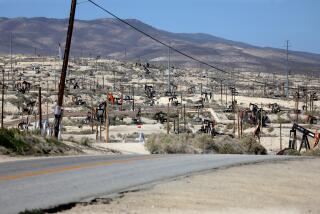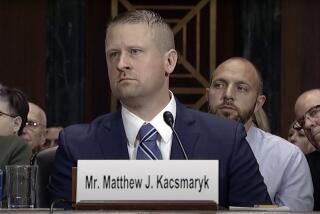Judge Giles Rich; Patent Law Authority
- Share via
Giles S. Rich, a judge of the U.S. Court of Appeals who was widely regarded as the century’s preeminent lawyer, jurist and scholar in the patent field, has died.
Rich succumbed to lymphoma Thursday at Sibley Memorial Hospital in Washington. He was 95 and at his death was the oldest active federal judge in the nation’s history.
In the often arcane world of inventions and patent law, Rich’s rulings helped establish the legal cornerstones for industries such as biotechnology, information technology and software.
His legal career spanned advising clients on patents for talking motion pictures to ruling on whether life forms could be patented. It ranged from a time when patents were enforced unevenly to a time when even theories and concepts could be protected under patent law.
Rich was appointed to the U.S. Court of Customs and Patent Appeals, a forerunner of the Federal Circuit U.S. Court of Appeals, by President Dwight D. Eisenhower in July 1956. He achieved the distinction of longest serving judge on March 28, 1997.
Bad eyesight kept Rich from his first love, commercial aviation, and led him to a career in law.
Giles Sutherland Rich was born in Rochester, N.Y., on May 30, 1904. His father, Giles Willard Rich, was a patent attorney handling, among other things, work for Eastman Kodak. When Giles was in high school, the family moved to New York City and Giles graduated from the Horace Mann School for Boys in 1922.
He always had great curiosity for things mechanical and technical--rebuilding radio sets for friends. When he went to ROTC training during his undergraduate days at Harvard, Rich spent some of his time taking apart 12-cylinder engines and reassembling them. He graduated with a bachelor’s degree in history, government and economics in 1926. Three years later he received a law degree from Columbia University and was admitted to the New York Bar.
Rich’s interest in patent law really took hold at Columbia, which ironically offered no courses in the specialty.
One of his teachers made him an offer--he could write a paper on patent law and get credit for it as a course. Rich accepted. “And I wrote him all you need to know about patent law, from soup to nuts--50 pages of legal-size paper,” Rich once told a reporter for a legal journal. And that, he added, “is how I taught myself patent law at Columbia Law School.”
Just before the stock market crash of 1929, he entered his father’s firm, Williams, Rich and Morse.
“One of the first jobs I had was to take a stack of patents on talking moving pictures and study them and give advice to clients,” Rich recalled.
During 27 years in private legal practice, Rich helped inventors get patents on “the greatest variety of stuff you can imagine”--a dump truck, an electrical switching device, even an air-raid shelter. But in practicing and studying patent law, he found the law terribly vague despite its solid historic foundation, Rich said, as “the first piece of legislation passed after the Constitution was adopted. . . . George Washington signed it in 1790.”
By the late 1940s, the Patent Office and the courts were still using the century-old standard that only “an invention” could be patented--a benchmark that many lawyers found subjective. So in the late 1940s, Rich and some colleagues began what was to be a four-year project to draft more precise definitions of just what could be patented. That legislation became the 1952 patent law and introduced the notion of “nonobviousness.” That theory held that an item could be patented if it was not obvious to a person of ordinary skill working in the area of the proposed patent at the time it was developed.
Another key element in the 1952 law concerned patent infringement. Rich and his colleagues provided language that clarified when a patent owner might sue for infringement on part of what was contained in the patent.
Passage of the law was only a step in the process to have these new standards accepted by the Patent Office and the courts. Rich spent years lobbying, lecturing and writing about the new law. Finally, in 1966, the Supreme Court upheld the “nonobviousness” standard in Graham vs. John Deere Co. and, as Rich said, “We turned the corner.”
Thirteen years later, Rich wrote what he considered to be his most important decision. That case involved the patent application for a genetically engineered strain of bacteria that could help break down crude oil.
The Patent Office had ruled that it could not patent anything that was alive. Rich took the position that living substances could, indeed, be protected by patent. Rich’s ruling for the Court of Appeals was upheld by the Supreme Court and basically opened the door for the biotechnology industry.
In another important decision, Rich ruled that mathematical algorithms could be patented. That ruling was seen as one of the legal cornerstones of the computer, information and software industries.
Throughout his long career, Rich kept up with the startling changes in technology. He took a fairly expansive view on the issue of patentability, believing that almost all software was patentable, as long as there is some possible application for it in the real world.
“He loved patent law. He loved his work,” Donald R. Dunner, a patent lawyer, recently told the Washington Post. “I think that’s one of the things that kept him alive. His interest never waned.”
An even temperament and a moderate lifestyle also helped keep him going, colleagues said. He never took senior judge status and continued to take a full caseload. He was still hearing arguments on cases just days before his death.
Rich could be firm and did not suffer fools gladly, including lawyers and other judges:
“When judges make egregious mistakes, we try to straighten them out,” he said.
His contact with law clerks stimulated Rich.
“I like working with them,” he once told an interviewer. “I’m not working with a bunch of old dodos about to retire.”
One court watcher recalled seeing Rich at Union Station in Washington, D.C., recently, accompanied by some young people. “I looked over and there he was--walking toward the train pulling his own bag.”
He is survived by his wife, Helen; a daughter from a previous marriage and a granddaughter.
More to Read
Inside the business of entertainment
The Wide Shot brings you news, analysis and insights on everything from streaming wars to production — and what it all means for the future.
You may occasionally receive promotional content from the Los Angeles Times.










